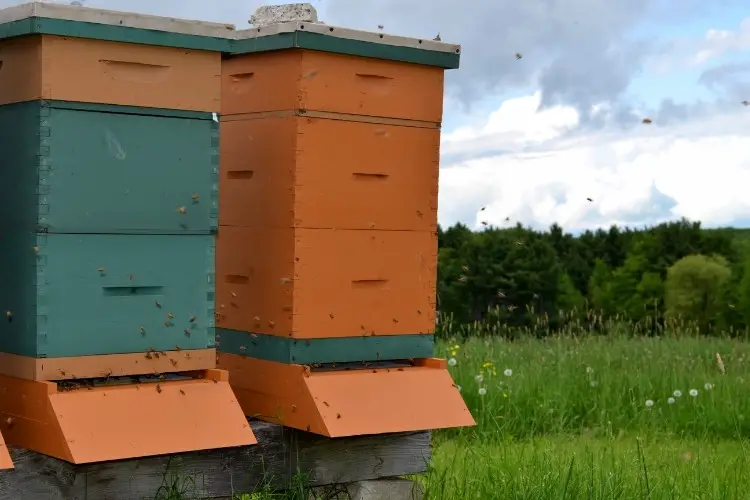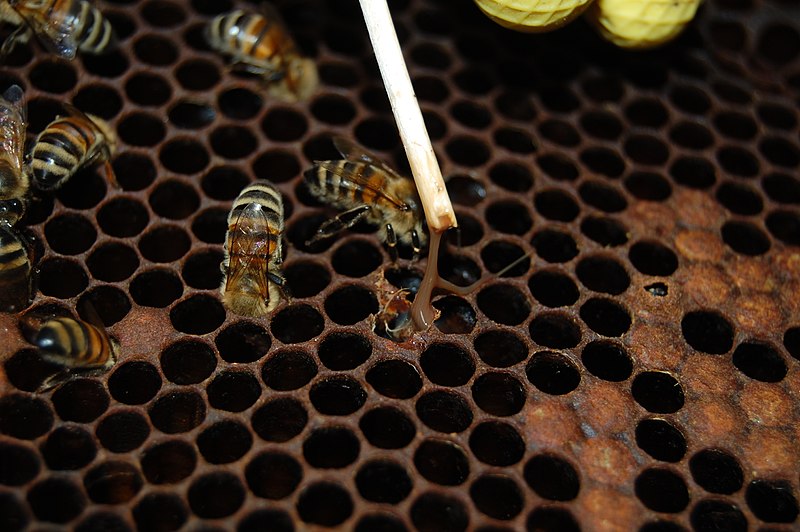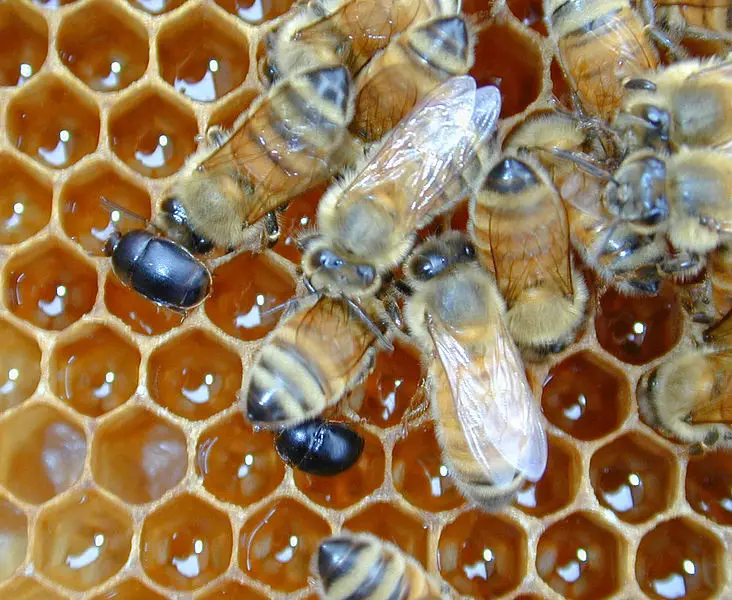When you inspect your beehive, the smell you notice should either be of honey, or of nothing at all.
A sweet honey scent would be evident in spring at the height of the honey-making season, or when there is a nectar flow and plenty of nectar to collect.
At other times, you won’t notice a particular smell. Bees are clean insects so they don’t allow their hive to get dirty, instead, they defecate on the wing and carry dead bees or other insects from the hive.
So, if you notice a sour smell coming from your beehive, you can generally assume that something is wrong and needs investigation. This is especially important because it could be a disease or a pest – a signal that your girls need your help.

Let’s look at some of the reasons why your hive could smell sour.
1. American Foulbrood (AFB)
American foulbrood (AFB) is a nasty bacterial disease that attacks the larvae and pupae within a hive and is very contagious. It has an unpleasant odor and if left unchecked it will certainly kill the whole colony.
The spores of American Foulbrood are very resistant to heat, direct sunlight, dehydration and many chemical disinfectants and drugs used to treat the disease. They can remain viable for fifty years, perhaps longer, and are present in the honey, comb, wax and hive components.
One of the characteristics of American Foulbrood is an unpleasant, foul smell that’s noticed as you open up the hive. Other characteristics include:
- Infected larvae change color from a pearly white to a dull tan or dark brown and they die after they have been capped.
- The caps of the dead brood sink inward (concave) and can appear perforated with tiny holes.
- The surface of the caps may appear wet or slimy.
- The cell pattern of healthy brood is normally bright and compact with lots of capped cells together in a band across the frame. However if it’s spotty with random cells covered with sunken perforated caps then it could be AFB.

If you see these symptoms in your hive and suspect AFB, you can confirm your suspicions by putting a wooden toothpick or match into one of the dead brood, mixing it around and then slowly withdrawing it. Look at the material that you withdraw. If it is stringy or ropey then you’ve got good reason to believe it’s American Foulbrood and further action is needed.
What You Should Do About It
If you think your hive has American Foulbrood then the first thing to do is immediately put the hive back together and reduce the entrance to prevent robbing. If the hive’s in the sun, move it into the shade to stop it from melting and leaking honey because the honey too will have spores of AFB, and you don’t want to spread it to other bees that might come and rob the hive.
Contact your state or territory apiary officer or inspector immediately to get them to confirm your diagnosis, because AFB is a notifiable disease. If you don’t let the authorities know, you are breaking the law and risking the health of many other colonies of bees.
There is also a test kit you can purchase to confirm your thoughts.
The treatment of AFB is subject to state law in the United States. If It is out of control, then most likely all your hives and equipment will have to be burned and destroyed, then buried.
In Australia, American Foulbrood requires all hive components of infected hives, including bees, to be burned in a pit then buried under at least 30 centimeters (1 foot) of soil because it’s such a contagious disease.
Remember all your hive tools and protective clothing and gloves should be cleaned thoroughly after each hive inspection. If you have more than one hive, you need to clean everything before examining the next hive or use a new, clean set of equipment.
2. European Foulbrood (EFB)
Considered not as sinister as American Foulbrood is the bacterial disease European Foulbrood or EFB. European Foulbrood also attacks the larvae and in advanced cases can have a foul, sour odor, similar to rotten oranges.
Some of the other symptoms of EFB are:
- The larvae in the cells affected by EFB are tan or yellowish in color and have a smooth, ‘melted’ appearance whereas healthy larvae are bright, pearly white, and glistening.
- Unlike a healthy, compact brood pattern, in combs with European Foulbrood, the brood pattern is patchy with many empty cells scattered among the capped brood.
Infected larvae die before the cell is capped, so it’s easier for you to see the affected larvae.
Although capped cells might be sunken and perforated, the toothpick test won’t always result in the remains’ stringy or ropey appearance.
What You Should Do About It
First of all, you should get a second, expert opinion to be sure of the disease affecting your hive.
Diagnosis of EFB may be confirmed by taking a sample of diseased larvae, putting it on a slide, and submitting it to a laboratory.
EFB isn’t considered as catastrophic as AFB, but it’s still highly contagious and combs can remain infectious for two years.
Keeping your hive strong will help your colony prevent or keep the disease at bay. A young vigorous queen, a good flow of nectar and supply of fresh pollen can help your bees resist the disease or recover from it.
A strong hive of bees will remove the diseased larvae from the hive. You can help your hive by using tweezers to remove infected larvae.
Annual replacement of approximately 20% to 25% of old dark comb in your hive may reduce the number of bacteria present.
3. Small Hive Beetle (SHB)
The small hive beetle is a small black pest whose larvae can devastate your hive by eating everything in it – including the wax, pollen, honey and all the stages of bee brood.

The larvae carry a yeast that contaminates the honey, causing it to ferment. As it oozes out of the cells, the fermenting honey froths up and there’s an odor similar to that of rotting oranges. The larvae cover everything in slime as they go.
Queen bees in a badly affected hive may stop laying and the bees may decide to leave the hive to find another home.
What You Should Do About It
You can prevent small hive beetle by keeping your colonies strong. Beetles prefer to occupy weak hives. Make sure your queen is young and laying well. A strong colony with plenty of bees will deter the small hive beetle.
Remove any unoccupied boxes of frames your bees are not using, because the beetle larvae prefer to attack empty combs.
Maintain good hygiene in and around the hive. Don’t leave any discarded comb or wax scraps around your hive to attract the beetles and encourage them to breed. Take out the bottom board regularly and clean it.
To help reduce the number of small hive beetle, you can install hive beetle traps like these ones. They fit between the frames and are filled with vegetable oil. Beetles end up drowning in the oil when they try to hide.
4. The Honey Is Fermenting
If the sour smell coming from your hive isn’t caused by a disease or pest I’ve previously outlined, then it could be caused by honey fermenting in the cells of your hive. Honey with a moisture level above approximately 18% won’t be capped by bees and could start to ferment in the cells.
Yeasts growing in the honey produce alcohol and carbon dioxide, which you can tell because of the smell of alcohol from the hive. When you look at the cells of honey you’ll be able to see they are frothy.
Partly ripened honey may ferment when conditions are very humid, or the nectar gathered has a high moisture content. Sometimes the bees won’t have enough time to ripen honey collected in late fall (autumn) or winter.
Honey can ferment in the jar too. If you remove frames of honey that aren’t fully capped, the open cells might not be sufficiently ripened and the honey could start to ferment after you’ve extracted it. If your storage containers aren’t airtight, honey can absorb moisture from the air and start to ferment.
What You Should Do About It
You should be cautious when taking a frame of honey for extraction. Wait until approximately 90% of the cells are capped before removing them from the hive. A good tip is to hold the frame horizontally and shake it to see if any of the ripening honey falls out of the cells. If it does, then it’s not ready for extraction.
If you have fermenting honey in your hive, it’s best to remove it and take it away to be extracted and later disposed of. Don’t leave it outside the hive as it will attract unwanted visitors. It shouldn’t be fed to your bees either because it can make them sick.
5. Floral Source
Sometimes the smell in your beehive could be attributed to the flowers the bees are gathering nectar from. Certain flowers in bloom throughout the year may give off a strong odor.
The nectar of Goldenrod, for example, a plant that blooms in certain states of the U.S. gives off a peculiar odor when the nectar is ripening in the hive.
What You Should Do About It
First, ensure the odor is not caused by a disease or pest in your hive. If you decide the smell is from a floral source, take a look in your garden and around your neighborhood to see what is in bloom at that time of the year.
If you’re unsure of the source, you can also ask another local experienced beekeeper. They might be able to tell you which flower is causing the odor.
6. You Are A New Beekeeper
If you’re new to beekeeping and aren’t familiar with the smells associated with the hobby, such as the smell of the wax, the pollen, nectar, honey, the hive components, and the bees themselves, you might find the smell a bit peculiar at first.
To be sure about where the odor is coming from, get an experienced beekeeper with local knowledge to help inspect your hive and determine the cause of the smell. As long as you can discount diseases, pests, and fermenting honey, then it could just be that you aren’t used to the new smells.
What You Should Do About It
There is nothing to do about it really… as you become more experienced in dealing with your hive you will know what odors are normal and which are not.
Final Thoughts…
There are many reasons why your hive might smell bad or sour. Regular inspections allow you to check for signs of disease or pests before they get out of hand. Once the bad odor is detected, the problem is often advanced and will need you to take immediate action.
If you’re inexperienced, don’t be afraid to ask for help from another beekeeper if you detect a sour smell in your hive. You’ll learn from them, and chances are the cause of the odor is not as bad as you initially thought.
